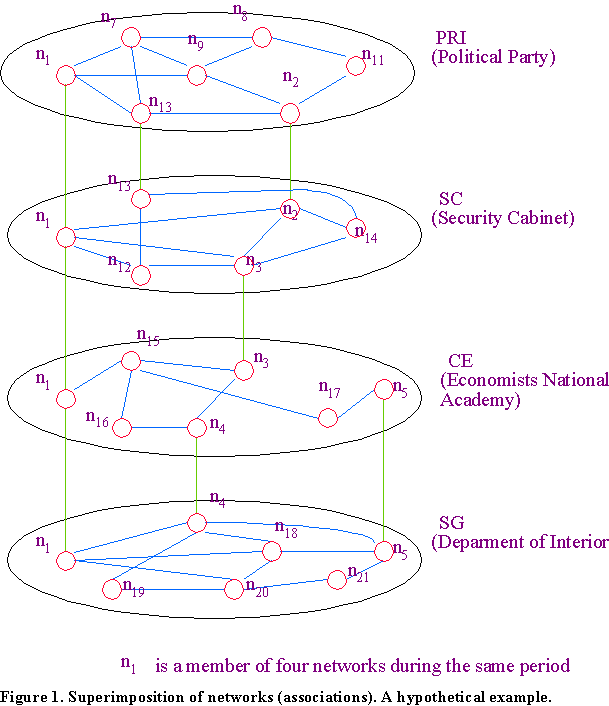
| Article |
|---|
CONNECTIONS 20(2):34-55
©1997 INSNA
Jorge Gil Mendieta (2)
Universidad Nacional Autónoma de México, (UNAM)
Samuel Schmidt (3)
University of Texas, El Paso
Jorge Castro (2)
Universidad Nacional Autónoma de México, (UNAM)
Alejandro Ruiz (4)
Universidad Nacional Autónoma de México, (UNAM)
We have undertaken the project to understand the configuration, function and role of the Mexican network of power. Previous studies have focused on the recruitment and education of Mexican political leaders and rulers (Camp 1980), the path of their political careers (Smith 1979), their technical skills (Centeno 1994), the creation of cliques (Camp 1990) and the development of networks as an instrument for delivering benefits to their constituents (González-Matinez, 1995). It is our objective here to examine the network's topology, function and centrality values.
In previous publications we have described the network's historical evolution (Schmidt and Gil 1994), the creation of cliques inside the network (Schmidt and Gil 1993), the control of the basic political functions in the political system with emphasis on presidential succession (Schmidt and Gil 1991), and the role the network plays in insuring political stability and controlling conflict (Schmidt and Gil 1995). At length, we were able to develop an index to analyze the centrality of actors and cliques (Gil and Schmidt 1996).
Although we have explored all these facets, our analyses have failed to investigate the dynamic changes that take place in the network. In previous articles we have analyzed the network as a whole, without assuming any changes. Even though the network retains the same function over time, its configuration undergoes modifications as a result of internal and external alterations, creating a cycle of mutually-determined variation: changes in the network affect the country, and changes in the country impact the network.
In this article we address the dynamic change of the network, assuming that the disappearance and inclusion of new actors changes the concentration of power. We consider disappearance to be fixed by date of death and inclusion of new actors to be marked by the time they became politically active. Both disappearance and inclusion occur continually, and in both cases the concentration of power changes because the disappearance of actors eliminates connections and the inclusion of actors creates different cliques, redefining centrality within and among cliques.
The information supporting this analysis is kept at REDMEX, a data base developed by the authors at Laboratorio de Gráficas, which is housed at the Institute for Applied Mathematics (IIMASS) located at the UNAM. The REDMEX data base currently contains about 5,400 entries detailing personal and political information on members of the Mexican government, including the executive, legislative (congress and senate), and judicial branches as well as officials of government-owned corporations and state governors. Each computer record contains sixteen indicators such as personal information (age, parents, spouse), education, political activities (political party membership), membership in social groups (e.g., labor unions, peasant organizations), elected positions, congressional positions, government positions, professional activities, academic positions, publications, membership in professional groups (e.g., Mexican Association of Computer Science), awards and decorations, international representations, and commissions (mostly refers to the military). The analysis for this paper takes into account the network's 37 core actors, who have played a central role in Mexican politics after the 1910 revolution, including all the presidents and some of the actors they and others, especially historians and political scientists, have described as influential. Our analysis of connectivity explains which of these actors influence political events -- mainly the control of the presidency -- and defines the cliques and their changing values. The dynamic approach shows the evolving values of cliques over time and the varying ways in which actors in different cliques intersect.
The Mexican network of power is a hypergraph. For this article we have analyzed only the core, which comprises 37 actors. We discovered that the network is actually a superimposition of structures, where an actor often belongs to various networks simultaneously. Figure 1 shows the hypothetical case where one politician belongs to four different networks.

In this hypothetical case, one actor belongs to the ruling PRI party, to the Department of the Interior (this department belongs to the national security cabinet, which is another network) and also to a professional association for economists.
A network is formed by dyads interconnected by links, representing formal, informal and organizational relationships. A network is the logical sum of networks or subnetworks. This can be summarized as:
N= N1 U N2 U ... U Nm
where Nj and Nk (for j not equal to k) may have common nodes.
Each group or subnetwork (Nj) represents the points of coincidence of a set of groups based on their common belonging (school, sports, business, political participation), or a common interest (political power). The group's bonding creates a distinctive sense of belonging which impacts the nature of the network.
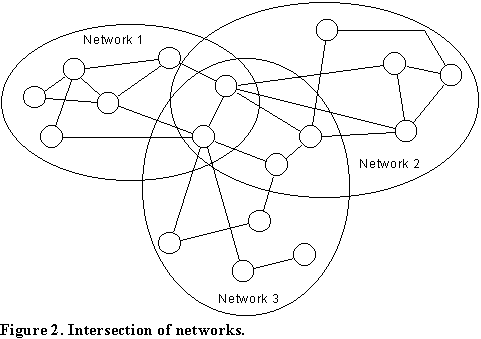
The topology of a network shows the flow of information and pattern of relationships. Networks can be more or less centralized, and network analysis helps identify cliques, the number of connections, paths (shortest, longest), groups, factions, etc. A very centralized network usually shows cohesion and includes influential cliques.
The influence individuals have within the network is determined by their centrality, which results from participation, simultaneously or over time, in various networks. Individuals who participate in the intersection of networks (Fig. 2) have more influence because they become a central node with different resource mobilization capabilities (Schmidt and Gil 1995 and Gil and Schmidt 1996).
The president is the most powerful actor in the network, due to constitutional and meta-constitutional attributes (Carpizo 1978, Schmidt 1991). In his career his power increases along with the creation of new connections and reaches its highest point when he becomes president; however, some actors, who eventually are placed in different network intersections, might have a higher power index and be active beyond any single presidential administration.
It is important for an actor to have connections with other cliques because the intersection of cliques facilitates the mobilization of multiple resources and can determine an actor's political career, even a solidifying a bid for the presidency, as we showed was the case of Ruiz Cortines, who became president in 1952 (Schmidt and Gil 1993). The intersections also explain the network's cohesion and why some groups remain in power for extended periods of time. Still, we have to assume that the disappearance of some actors and inclusion of others has to alter the intersections and redistribute influence and power.
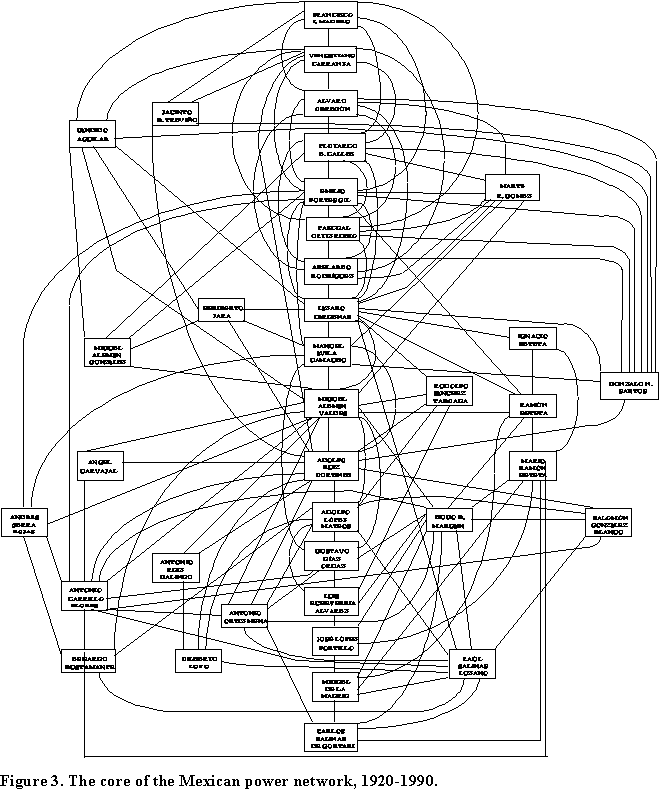
In this article we analyze the changing nature of the power core by slicing its evolution into decade-long segments. The general figure includes all presidents since the 1910s up until 1994, a period in which we identify three generations. The first was involved in the 1910 revolution, was strongly connected to the revolutionary army (e.g., Cárdenas) and disappears around the 70s.
Table 1
Individual Centrality, 1920-1990
| 1920-90* | 1940 | 1950 | 1960 | 1970 | 1980 | 1990 | ||
| 1 | Madero, Francisco | 0,502 | ||||||
| 2 | Carranza, Venustiano | 0,564 | ||||||
| 3 | Obregón, Alvaro | 0,550 | ||||||
| 22 | Alemán González, Miguel | 0,518 | ||||||
| 4 | Calles, Plutarco E. | 0,564 | 0,657 | |||||
| 25 | Sánchez Taboada, Rodolfo | 0,548 | 0,583 | 0,591 | ||||
| 9 | Avila Camacho, Manuel | 0,601 | 0,722 | 0,705 | ||||
| 18 | Aguilar, Cándido | 0,561 | 0,602 | 0,583 | ||||
| 6 | Ortiz Rubio, Pascual | 0,550 | 0,657 | 0,568 | 0,540 | |||
| 26 | Beteta, Ramón | 0,583 | 0,593 | 0,576 | 0,558 | |||
| 7 | Rodriguez, Abelardo L. | 0,537 | 0,657 | 0,568 | 0,540 | |||
| 23 | Jara, Heriberto | 0,529 | 0,611 | 0,583 | 0,514 | |||
| 12 | López Mateos, Adolfo | 0,596 | 0,629 | 0,667 | ||||
| 8 | Cárdenas, Lázaro | 0,706 | 0,889 | 0,795 | 0,710 | |||
| 19 | Treviño, Jacinto B. | 0,476 | 0,509 | 0,492 | 0,486 | 0,448 | ||
| 33 | Loyo Gilberto | 0,482 | 0,536 | 0,504 | ||||
| 11 | Ruiz Cortines, Adolfo | 0,662 | 0,685 | 0,720 | 0,732 | 0,688 | ||
| 20 | Gómez, Marte R. | 0,570 | 0,676 | 0,621 | 0,580 | 0,479 | ||
| 21 | Santos, Gonzalo N. | 0,594 | 0,750 | 0,674 | 0,609 | 0,489 | ||
| 5 | Portes Gil, Emilio | 0,654 | 0,741 | 0,652 | 0,645 | 0,546 | ||
| 13 | Díaz Ordaz, Gustavo | 0,553 | 0,538 | 0,565 | 0,592 | |||
| 30 | Ruiz Galindo, Antonio | 0,482 | 0,508 | 0,529 | 0,529 | 0,446 | ||
| 10 | Alemán Valdés, Miguel | 0,737 | 0,722 | 0,795 | 0,761 | 0,742 | 0,738 | |
| 28 | Carvajal, Angel | 0,487 | 0,508 | 0,536 | 0,538 | 0,506 | ||
| 31 | Carrillo Flores, Antonio | 0,623 | 0,688 | 0,742 | 0,738 | |||
| 24 | Beteta, Ignacio | 0,469 | 0,519 | 0,477 | 0,446 | 0,353 | 0,417 | |
| 32 | Bustamante, Eduardo | 0,535 | 0,545 | 0,565 | 0,600 | 0,667 | 0,633 | |
| 36 | González Blanco, Salomón | 0,518 | 0,472 | 0,508 | 0,551 | 0,583 | 0,583 | 0,583 |
| 29 | Serra Rojas, Andrés | 0,531 | 0,546 | 0,568 | 0,551 | 0,558 | 0,560 | 0,425 |
| 34 | Ortiz Mena, Antonio | 0,575 | 0,609 | 0,642 | 0,631 | 0,633 | ||
| 35 | Margáin, Hugo B. | 0,614 | 0,708 | 0,821 | 0,883 | |||
| 37 | Salinas Lozano, Raúl | 0,614 | 0,537 | 0,568 | 0,645 | 0,617 | 0,690 | 0,800 |
| 15 | López Portillo, José | 0,434 | 0,492 | 0,607 | 0,683 | |||
| 14 | Echeverría Alvarez, Luis | 0,480 | 0,438 | 0,475 | 0,512 | 0,558 | ||
| 27 | Beteta, Mario Ramón | 0,507 | 0,525 | 0,655 | 0,750 | |||
| 16 | De la Madrid Hurtado, Miguel | 0,493 | 0,607 | 0,733 | ||||
| 17 | Salinas de Gortari, Carlos | 0,498 | 0,733 |
*This column shows the whole network values without any cuts. Source: Jorge Gil-Mendieta, S. Schmidt, J. Castro and A. Ruiz, REDMEX data base, 1997. Laboratorio de Gráficas, IIMAS-UNAM.
The second appears around the 1940s, has some family connection to the first generation (e.g., Miguel Alemán) and includes some actors who are still present today. The third generation enters the network between 1970 and 1980 and has family connections to the second generation (e.g., Carlos Salinas de Gortari)(5). In the general graph (Figure 3, Table 1) the centrality index (In)(6) is higher for those with a direct role during the 1910 revolution and those having connections with them, but as we move along we will see an important distribution of values.
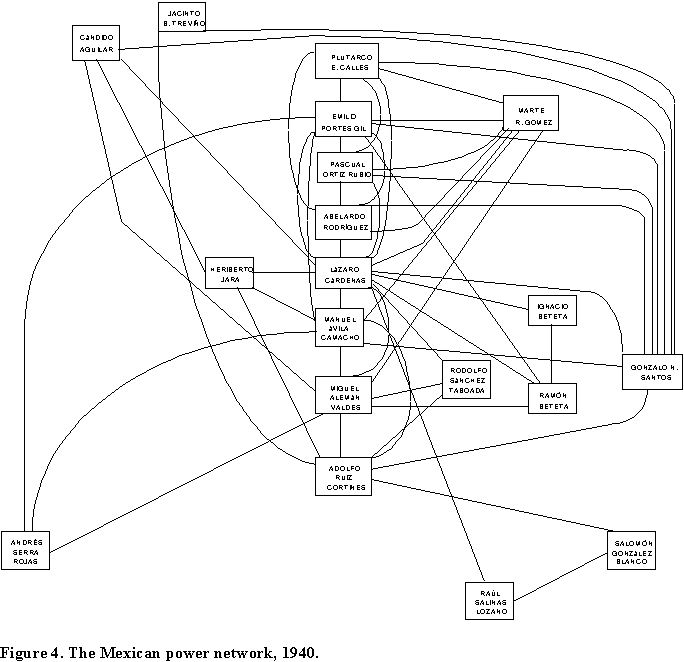
Table 2
Individual Centrality, 1940
| # of Nodes at Distance ... |
|||||
| Node | Name | 3 | 2 | 1 | Centrality |
| 8 | Cárdenas, Lázaro | 0 | 4 | 14 | 0,889 |
| 21 | Santos, Gonzalo N. | 0 | 9 | 9 | 0,750 |
| 5 | Portes Gil, Emilio | 1 | 8 | 9 | 0,741 |
| 9 | Avila Camacho, Manuel | 0 | 10 | 8 | 0,722 |
| 10 | Alemán Valdés, Miguel | 0 | 10 | 8 | 0,722 |
| 11 | Ruiz Cortines, Adolfo | 1 | 10 | 7 | 0,685 |
| 20 | Gómez, Marte R. | 2 | 9 | 7 | 0,676 |
| 4 | Calles, Plutarco E. | 1 | 11 | 6 | 0,657 |
| 6 | Ortiz Rubio, Pascual | 1 | 11 | 6 | 0,657 |
| 7 | Rodriguez, Abelardo L. | 1 | 11 | 6 | 0,657 |
| 23 | Jara, Heriberto | 0 | 14 | 4 | 0,611 |
| 18 | Aguilar, Cándido | 1 | 13 | 4 | 0,602 |
| 26 | Beteta, Ramón | 2 | 12 | 4 | 0,593 |
| 25 | Sánchez Taboada, Rodolfo | 0 | 15 | 3 | 0,583 |
| 29 | Serra Rojas, Andrés | 4 | 11 | 3 | 0,546 |
| 37 | Salinas Lozano, Raúl | 2 | 14 | 2 | 0,537 |
| 24 | Beteta, Ignacio | 4 | 12 | 2 | 0,519 |
| 19 | Treviño, Jacinto B. | 5 | 11 | 2 | 0,509 |
| 36 | González Blanco, Salomón | 9 | 7 | 2 | 0,472 |
Table 3
Clique Centrality, 1940
| # of Nodes at Distance |
||||
| Clique | 3 | 2 | 1 | Centrality |
| 5,8,9,21 | 0 | 1 | 14 | 0,967 |
| 4,5,6,7,8,21 | 0 | 1 | 12 | 0,962 |
| 5,8,26 | 0 | 2 | 14 | 0,938 |
| 8,10,18 | 0 | 2 | 14 | 0,938 |
| 8,10,25 | 0 | 2 | 14 | 0,938 |
| 8,10,26 | 0 | 2 | 14 | 0,938 |
| 8,18,21 | 0 | 2 | 14 | 0,938 |
| 8,9,23 | 0 | 2 | 14 | 0,938 |
| 5,8,9,20 | 0 | 2 | 13 | 0,933 |
| 8,9,10,20 | 0 | 2 | 13 | 0,933 |
| 8,18,23 | 0 | 3 | 13 | 0,906 |
| 9,11,21 | 0 | 3 | 13 | 0,906 |
| 4,5,6,7,8,20 | 0 | 3 | 10 | 0,885 |
| 9,10,11 | 0 | 5 | 11 | 0,844 |
| 11,19,21 | 0 | 5 | 11 | 0,844 |
| 9,11,23 | 0 | 6 | 10 | 0,813 |
| 10,11,25 | 0 | 6 | 10 | 0,813 |
| 5,9,29 | 0 | 6 | 10 | 0,813 |
| 9,10,29 | 0 | 7 | 9 | 0,781 |
| 8,24,26 | 0 | 8 | 8 | 0,750 |
We made the first cut in 1940, including two generations of politicians (Figure 4, Table 2). By 1940, actors {1, 2, 3, 22}(7) have already disappeared. In the tables starting in 1940 we have included the number of distances between the actors, and the proper In and Ic values. In this cut, the first generation has the highest In values, and they are in full control of the political system. All presidents are generals and built their network connections during the revolution. Some members of the second generation (Miguel Alemán, Raúl Salinas Lozano) intersect between cliques and generations, and their In values are high. In 1940, 19 actors had 20 cliques showing high clique centrality (IC) values (see Table 3).
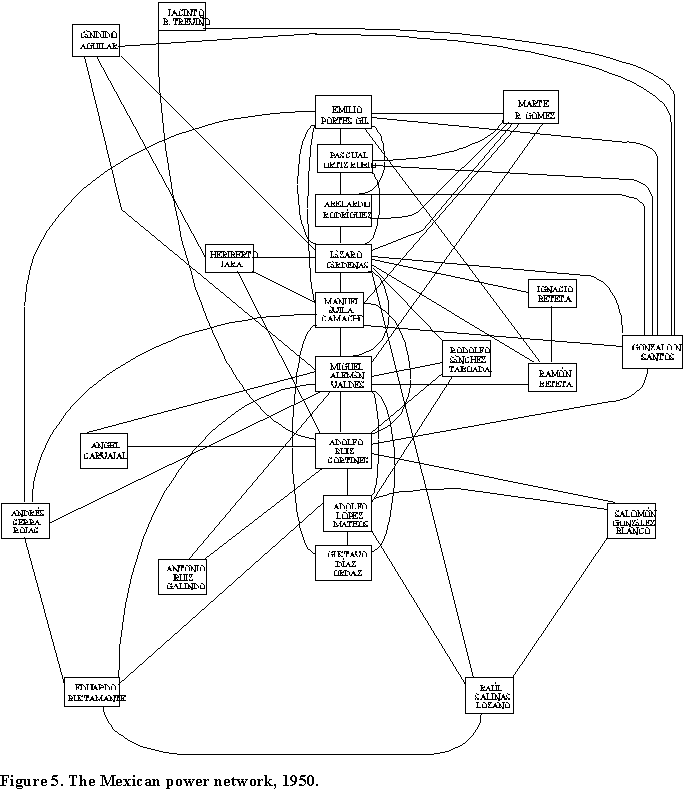
Table 4
Individual Centralities, 1950
| # of Nodes at Distance ... |
Centrality |
||||
| Node | Name |
3 | 2 | 1 | In |
| 8 | Cárdenas, Lázaro | 0 | 9 | 13 | 0,795 |
| 10 | Alemán Valdés, Miguel | 0 | 9 | 13 | 0,795 |
| 11 | Ruiz Cortines, Adolfo | 1 | 11 | 10 | 0,720 |
| 9 | Avila Camacho, Manuel | 0 | 13 | 9 | 0,705 |
| 21 | Santos, Gonzalo N. | 1 | 13 | 8 | 0,674 |
| 5 | Portes Gil, Emilio | 4 | 10 | 8 | 0,652 |
| 12 | López Mateos, Adolfo | 4 | 11 | 7 | 0,629 |
| 20 | Gómez, Marte R. | 2 | 14 | 6 | 0,621 |
| 25 | Sánchez Taboada, Rodolfo | 0 | 18 | 4 | 0,591 |
| 18 | Aguilar, Cándido | 1 | 17 | 4 | 0,583 |
| 23 | Jara, Heriberto | 1 | 17 | 4 | 0,583 |
| 26 | Beteta, Ramón | 2 | 16 | 4 | 0,576 |
| 6 | Ortiz Rubio, Pascual | 6 | 11 | 5 | 0,568 |
| 7 | Rodriguez, Abelardo L. | 6 | 11 | 5 | 0,568 |
| 29 | Serra Rojas, Andrés | 3 | 15 | 4 | 0,568 |
| 37 | Salinas Lozano, Raúl | 3 | 15 | 4 | 0,568 |
| 32 | Bustamante, Eduardo | 6 | 12 | 4 | 0,545 |
| 13 | Díaz Ordaz, Gustavo | 4 | 15 | 3 | 0,538 |
| 28 | Carvajal, Angel | 5 | 15 | 2 | 0,508 |
| 30 | Ruiz Galindo, Antonio | 5 | 15 | 2 | 0,508 |
| 36 | González Blanco, Salomón | 8 | 11 | 3 | 0,508 |
| 19 | Treviño, Jacinto B. | 7 | 13 | 2 | 0,492 |
| 24 | Beteta, Ignacio | 9 | 11 | 2 | 0,477 |
Table 5
Clique Centrality, 1950
| # of Nodes at Distance |
||||
| Clique | 3 | 2 | 1 | Centrality |
| 8,10,18 | 0 | 2 | 18 | 0,950 |
| 8,10,25 | 0 | 2 | 18 | 0,950 |
| 8,10,26 | 0 | 2 | 18 | 0,950 |
| 8,9,10,20 | 0 | 2 | 17 | 0,947 |
| 9,10,11 | 0 | 4 | 16 | 0,900 |
| 9,11,21 | 0 | 4 | 16 | 0,900 |
| 10,11,12,25 | 0 | 4 | 15 | 0,895 |
| 10,11,28 | 0 | 5 | 15 | 0,875 |
| 10,11,30 | 0 | 5 | 15 | 0,875 |
| 5,8,9,21 | 0 | 5 | 14 | 0,868 |
| 8,9,23 | 0 | 6 | 14 | 0,850 |
| 9,11,23 | 0 | 6 | 14 | 0,850 |
| 9,10,13 | 0 | 6 | 14 | 0,850 |
| 9,10,29 | 0 | 6 | 14 | 0,850 |
| 5,8,9,20 | 0 | 6 | 13 | 0,842 |
| 5,6,7,8,21 | 0 | 6 | 12 | 0,833 |
| 8,18,21 | 0 | 7 | 13 | 0,825 |
| 11,19,21 | 0 | 7 | 13 | 0,825 |
| 10,12,32 | 0 | 7 | 13 | 0,825 |
| 10,12,13 | 0 | 7 | 13 | 0,825 |
| 10,29,32 | 0 | 7 | 13 | 0,825 |
| 5,8,26 | 0 | 8 | 12 | 0,800 |
| 8,18,23 | 0 | 8 | 12 | 0,800 |
| 5,6,7,8,20 | 0 | 8 | 10 | 0,778 |
| 8,24,26 | 0 | 9 | 11 | 0,775 |
| 5,9,29 | 0 | 9 | 11 | 0,775 |
| 11,12,36 | 1 | 8 | 11 | 0,767 |
| 12,32,37 | 0 | 13 | 7 | 0,675 |
| 12,36,37 | 0 | 14 | 6 | 0,650 |
In 1950, centrality starts moving to the second generation (Figure 5, Table 4). Members of the first generation are present with high In values (e.g., Adolfo Ruiz Cortines), but the second generation shows high In values (e.g., Adolfo López Mateos, who actually became president in 1958). In 1950, 23 actors had 29 cliques with Ic values (Table 5), so the network is very cohesive.
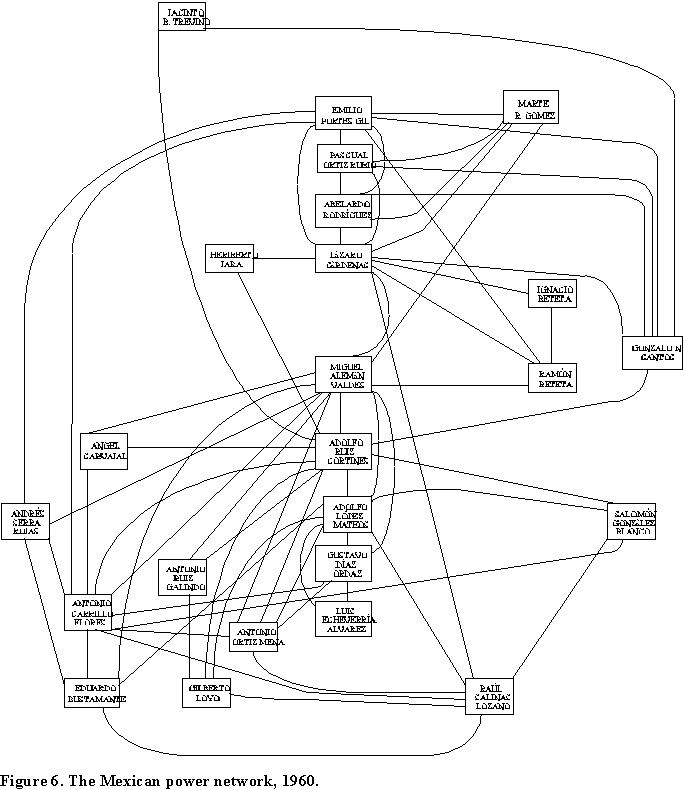
By 1960, the revolutionary leaders start disappearing (Figure 6, Table 6) and the In values of some of them start to decrease. Heriberto Jara has a 0.611 in 1940 and 0.514 in 1960; Lázaro Cárdenas has a 0.889 in 1940 and 0.710 in 1960. The values for the second generation increase because they are already in power, even though the first generation still holds on to its influence. Twenty-four actors have 28 cliques and the Ic values (Table 7) of the second generation fall short of the Ic values of the first generation in 1940.
Table 6
Individual Centrality, 1960
| # of Nodes at Distance ... |
||||||
| Node | Name |
4 | 3 | 2 | 1 | Centrality |
| 10 | Alemán Valdés, Miguel | 0 | 0 | 11 | 12 | 0,761 |
| 11 | Ruiz Cortines, Adolfo | 0 | 1 | 11 | 11 | 0,732 |
| 8 | Cárdenas, Lázaro | 0 | 1 | 12 | 10 | 0,710 |
| 31 | Carrillo Flores, Antonio | 0 | 1 | 13 | 9 | 0,688 |
| 12 | López Mateos, Adolfo | 0 | 4 | 10 | 9 | 0,667 |
| 5 | Portes Gil, Emilio | 0 | 4 | 11 | 8 | 0,645 |
| 37 | Salinas Lozano, Raúl | 0 | 1 | 15 | 7 | 0,645 |
| 21 | Santos, Gonzalo N. | 0 | 3 | 14 | 6 | 0,609 |
| 34 | Ortiz Mena, Antonio | 0 | 3 | 14 | 6 | 0,609 |
| 20 | Gómez, Marte R. | 0 | 4 | 14 | 5 | 0,580 |
| 13 | Díaz Ordaz, Gustavo | 0 | 6 | 12 | 5 | 0,565 |
| 32 | Bustamante, Eduardo | 0 | 6 | 12 | 5 | 0,565 |
| 26 | Beteta, Ramón | 0 | 4 | 15 | 4 | 0,558 |
| 29 | Serra Rojas, Andrés | 0 | 5 | 14 | 4 | 0,551 |
| 36 | González Blanco, Salomón | 0 | 5 | 14 | 4 | 0,551 |
| 6 | Ortiz Rubio, Pascual | 1 | 8 | 9 | 5 | 0,540 |
| 7 | Rodriguez, Abelardo L. | 1 | 8 | 9 | 5 | 0,540 |
| 28 | Carvajal, Angel | 0 | 4 | 16 | 3 | 0,536 |
| 33 | Loyo Gilberto | 0 | 7 | 12 | 4 | 0,536 |
| 30 | Ruiz Galindo, Antonio | 0 | 5 | 15 | 3 | 0,529 |
| 23 | Jara, Heriberto | 0 | 4 | 17 | 2 | 0,514 |
| 19 | Treviño, Jacinto B. | 0 | 8 | 13 | 2 | 0,486 |
| 24 | Beteta, Ignacio | 1 | 12 | 8 | 2 | 0,446 |
| 14 | Echeverría Alvarez, Luis | 3 | 10 | 8 | 2 | 0,438 |
Table 7
Clique Centrality, 1960
| # of Nodes at Distance |
||||
| Clique | 3 | 2 | 1 | Centrality |
| 8,10,20 | 0 | 4 | 17 | 0,905 |
| 8,10,26 | 0 | 4 | 17 | 0,905 |
| 10,11,28,31 | 0 | 4 | 16 | 0,900 |
| 10,11,31,34 | 0 | 4 | 16 | 0,900 |
| 10,11,12,34 | 0 | 4 | 16 | 0,900 |
| 10,11,30 | 0 | 6 | 15 | 0,857 |
| 10,12,32 | 0 | 7 | 14 | 0,833 |
| 5,29,31 | 0 | 7 | 14 | 0,833 |
| 10,13,31,34 | 0 | 7 | 13 | 0,825 |
| 10,12,13,34 | 0 | 7 | 13 | 0,825 |
| 11,19,21 | 0 | 8 | 13 | 0,810 |
| 11,12,33 | 0 | 8 | 13 | 0,810 |
| 11,12,36 | 1 | 7 | 13 | 0,802 |
| 11,31,36 | 1 | 7 | 13 | 0,802 |
| 10,29,31,32 | 0 | 8 | 12 | 0,800 |
| 31,36,37 | 0 | 10 | 11 | 0,762 |
| 31,32,37 | 0 | 10 | 11 | 0,762 |
| 31,34,37 | 0 | 10 | 11 | 0,762 |
| 5,6,7,8,21 | 1 | 8 | 10 | 0,754 |
| 12,33,37 | 0 | 11 | 10 | 0,738 |
| 12,32,37 | 0 | 11 | 10 | 0,738 |
| 5,8,26 | 1 | 10 | 10 | 0,730 |
| 11,30,33 | 1 | 10 | 10 | 0,730 |
| 12,36,37 | 0 | 12 | 9 | 0,714 |
| 12,34,37 | 0 | 12 | 9 | 0,714 |
| 5,6,7,8,20 | 1 | 10 | 8 | 0,702 |
| 8,24,26 | 1 | 12 | 8 | 0,683 |
| 12,13,14 | 3 | 10 | 8 | 0,667 |
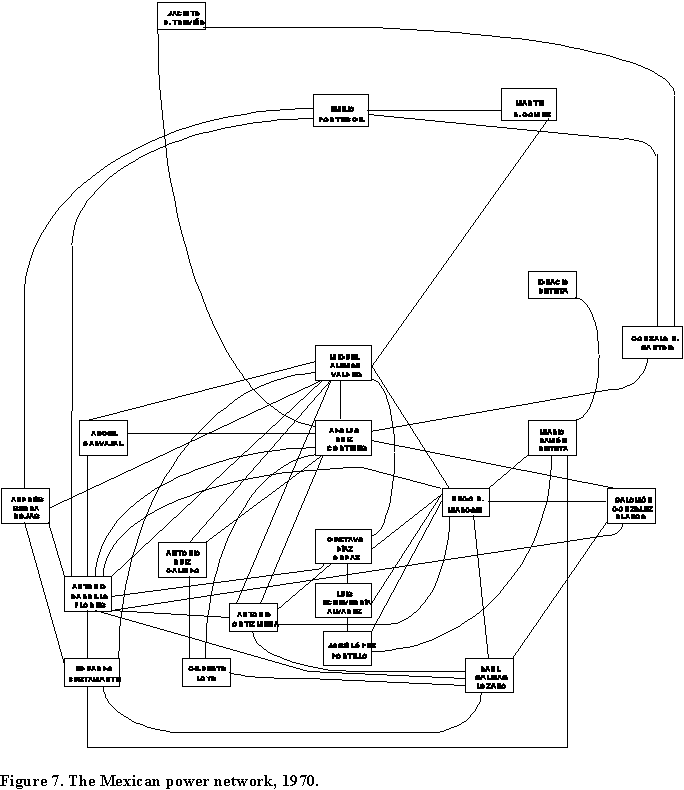
By 1970, only a few members of the first generation (Figure 7) are alive, and their In values are low (Table 8). The values for the second generation continue to increase, but not to the extent of reaching the first generation levels. In 1970, 21 actors have 15 cliques with low Ic values (Table 9) in comparison to the previous decade. Hypothetically, we can assume that the network started losing cohesion.
Table 8
Individual Centrality, 1970
| # of Nodes at Distance ... |
|||||||
Node |
Name |
5 | 4 | 3 | 2 | 1 | Centrality |
| 10 | Alemán Valdés, Miguel | 0 | 0 | 1 | 9 | 10 | 0,742 |
| 31 | Carrillo Flores, Antonio | 0 | 0 | 1 | 9 | 10 | 0,742 |
| 35 | Margáin, Hugo B. | 0 | 0 | 2 | 9 | 9 | 0,708 |
| 11 | Ruiz Cortines, Adolfo | 0 | 1 | 3 | 7 | 9 | 0,688 |
| 34 | Ortiz Mena, Antonio | 0 | 0 | 1 | 13 | 6 | 0,642 |
| 37 | Salinas Lozano, Raúl | 0 | 0 | 4 | 10 | 6 | 0,617 |
| 32 | Bustamante, Eduardo | 0 | 0 | 3 | 12 | 5 | 0,600 |
| 13 | Díaz Ordaz, Gustavo | 0 | 0 | 4 | 11 | 5 | 0,592 |
| 36 | González Blanco, Salomón | 0 | 0 | 2 | 14 | 4 | 0,583 |
| 29 | Serra Rojas, Andrés | 0 | 0 | 5 | 11 | 4 | 0,558 |
| 5 | Portes Gil, Emilio | 0 | 1 | 5 | 10 | 4 | 0,546 |
| 28 | Carvajal, Angel | 0 | 1 | 3 | 13 | 3 | 0,538 |
| 30 | Ruiz Galindo, Antonio | 0 | 1 | 4 | 12 | 3 | 0,529 |
| 27 | Beteta, Mario Ramón | 0 | 2 | 6 | 8 | 4 | 0,525 |
| 33 | Loyo Gilberto | 0 | 1 | 7 | 9 | 3 | 0,504 |
| 15 | López Portillo, José | 0 | 2 | 7 | 8 | 3 | 0,492 |
| 21 | Santos, Gonzalo N. | 1 | 3 | 4 | 9 | 3 | 0,489 |
| 20 | Gómez, Marte R. | 0 | 1 | 7 | 10 | 2 | 0,479 |
| 14 | Echeverría Alvarez, Luis | 0 | 2 | 9 | 6 | 3 | 0,475 |
| 19 | Treviño, Jacinto B. | 1 | 3 | 6 | 8 | 2 | 0,448 |
| 24 | Beteta, Ignacio | 2 | 6 | 8 | 3 | 1 | 0,353 |
Table 9
Clique Centrality, 1970
| # of Nodes at Distance ... |
||||||
| Clique | 5 | 4 | 3 | 2 | 1 | Centrality |
| 10,13,31,34,35 | 0 | 0 | 0 | 4 | 12 | 0.875 |
| 10,11,31,34 | 0 | 0 | 1 | 3 | 13 | 0.873 |
| 31,35,36,37 | 0 | 0 | 0 | 5 | 12 | 0.853 |
| 31,34,35,37 | 0 | 0 | 0 | 5 | 12 | 0.853 |
| 10,11,28,31 | 0 | 0 | 1 | 2 | 13 | 0.843 |
| 11,31,36 | 0 | 0 | 1 | 5 | 12 | 0.824 |
| 10,11,30 | 0 | 0 | 1 | 5 | 12 | 0.824 |
| 10,29,31,32 | 0 | 0 | 0 | 6 | 11 | 0.824 |
| 31,32,37 | 0 | 0 | 0 | 7 | 11 | 0.806 |
| 5,29,31 | 0 | 0 | 1 | 6 | 11 | 0.796 |
| 11,19,21 | 0 | 0 | 1 | 6 | 10 | 0.741 |
| 15,27,35 | 0 | 0 | 2 | 7 | 9 | 0.731 |
| 11,30,33 | 0 | 1 | 3 | 6 | 8 | 0.681 |
| 14,15,35 | 0 | 0 | 2 | 9 | 7 | 0.676 |
| 13,14,35 | 0 | 0 | 2 | 9 | 7 | 0.676 |
By 1980, some members of the third generation (Salinas) enter the network (Figure 8). The In values of some of the oldest members of the second generation (Miguel Alemán) start decreasing, even though the members of the second generation don't reach high values (Table 10). In 1980, the number of actors in the network's core decreases to 15, and the same happens to the number of cliques, which drops to 9 (Table 11). The number of intersections is also diminishing, reducing the number of influential actors.
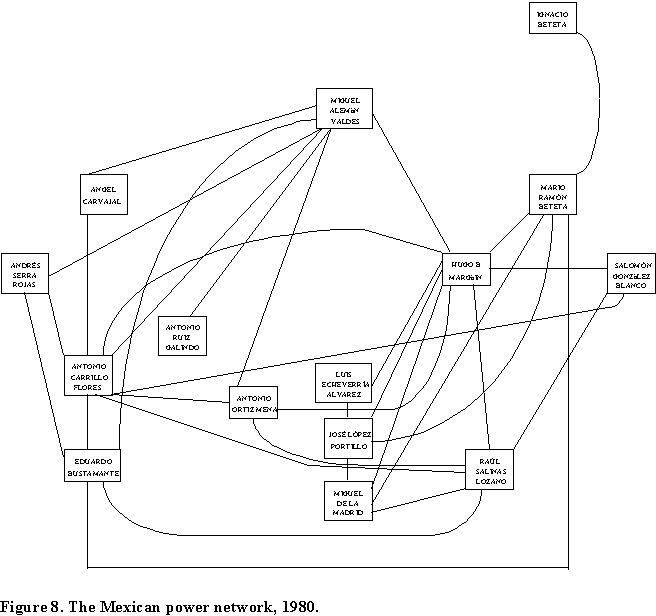
Table 10
Individual Centrality, 1980
| # of Nodes at Distance ... |
||||||
| Node | Name |
4 | 3 | 2 | 1 | Centrality |
| 35 | Margáin, Hugo B. | 0 | 0 | 5 | 9 | 0,821 |
| 31 | Carrillo Flores, Antonio | 0 | 1 | 6 | 7 | 0,738 |
| 10 | Alemán Valdés, Miguel | 0 | 1 | 6 | 7 | 0,738 |
| 37 | Salinas Lozano, Raúl | 0 | 2 | 6 | 6 | 0,690 |
| 32 | Bustamante, Eduardo | 0 | 1 | 8 | 5 | 0,667 |
| 27 | Beteta, Mario Ramón | 0 | 2 | 7 | 5 | 0,655 |
| 34 | Ortiz Mena, Antonio | 0 | 1 | 9 | 4 | 0,631 |
| 16 | De la Madrid Hurtado, Miguel | 0 | 3 | 7 | 4 | 0,607 |
| 15 | López Portillo, José | 0 | 3 | 7 | 4 | 0,607 |
| 36 | González Blanco, Salomón | 0 | 2 | 9 | 3 | 0,583 |
| 29 | Serra Rojas, Andrés | 0 | 4 | 7 | 3 | 0,560 |
| 14 | Echeverría Alvarez, Luis | 0 | 5 | 7 | 2 | 0,512 |
| 28 | Carvajal, Angel | 1 | 4 | 7 | 2 | 0,506 |
| 30 | Ruiz Galindo, Antonio | 1 | 6 | 6 | 1 | 0,446 |
| 24 | Beteta, Ignacio | 2 | 7 | 4 | 1 | 0,417 |
Table 11
Clique Centrality, 1980
| # of Nodes at Distance |
||||
| Clique | 3 | 2 | 1 | Centrality |
| 10,31,34,35 | 0 | 1 | 10 | 0,955 |
| 31,34,35,37 | 0 | 2 | 9 | 0,909 |
| 31,35,36,37 | 0 | 2 | 9 | 0,909 |
| 15,16,27,35 | 0 | 3 | 8 | 0,864 |
| 16,35,37 | 0 | 4 | 8 | 0,833 |
| 31,32,37 | 0 | 4 | 8 | 0,833 |
| 10,29,31,32 | 0 | 4 | 7 | 0,818 |
| 14,15,35 | 0 | 5 | 7 | 0,792 |
| 10,28,31 | 1 | 4 | 7 | 0,778 |
By 1990, the disappearance of the old politicians is complete, and the third generation is in power (Figure 9). The In values of actors (Table 12) who intersected cliques and generations are high (Raúl Salinas Lozano 0.800, Hugo B. Margáin 0.883), and new actors are attaining high ratings (Carlos Salinas 0.733). It is interesting, though, that while we made the cut in the middle of the Salinas administration, he did not have the highest In value among the members of the core and he did not reach the levels achieved by other actors in the 40s, 50s and 60s. The 11 actors had 6 cliques, most of them with high Ic values (Table 13), which suggests a small but cohesive group.
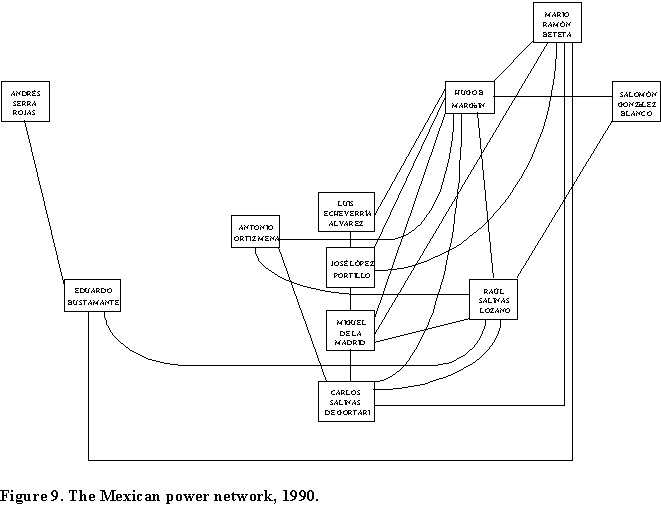
Table 12
Individual Centrality, 1990
| # of Nodes at Distance |
||||||
| Node | Name |
4 | 3 | 2 | 1 | Centrality |
| 35 | Margáin, Hugo B. | 0 | 1 | 1 | 8 | 0,883 |
| 37 | Salinas Lozano, Raúl | 0 | 0 | 4 | 6 | 0,800 |
| 27 | Beteta, Mario Ramón | 0 | 0 | 5 | 5 | 0,750 |
| 16 | De la Madrid Hurtado, Miguel | 0 | 1 | 4 | 5 | 0,733 |
| 17 | Salinas de Gortari, Carlos | 0 | 1 | 4 | 5 | 0,733 |
| 15 | López Portillo, José | 0 | 1 | 5 | 4 | 0,683 |
| 32 | Bustamante, Eduardo | 0 | 1 | 6 | 3 | 0,633 |
| 34 | Ortiz Mena, Antonio | 0 | 1 | 6 | 3 | 0,633 |
| 36 | González Blanco, Salomón | 0 | 1 | 7 | 2 | 0,583 |
| 14 | Echeverría Alvarez, Luis | 1 | 1 | 6 | 2 | 0,558 |
| 29 | Serra Rojas, Andrés | 1 | 6 | 2 | 1 | 0,425 |
Table 13
Clique Centrality, 1990
| # of Nodes at Distance |
||||
| Clique | 3 | 2 | 1 | Centrality |
| 35,36,37 | 0 | 1 | 7 | 0,938 |
| 16,17,27,35 | 0 | 1 | 6 | 0,929 |
| 16,17,35,37 | 0 | 1 | 6 | 0,929 |
| 15,16,27,35 | 0 | 1 | 6 | 0,929 |
| 17,34,35,37 | 0 | 1 | 6 | 0,929 |
| 14,15,35 | 1 | 1 | 6 | 0,854 |
The analysis of cliques shows a trend, where the first generation had strong connectivity peaking in 1950. Connectivity for the second generation seems to be lower, and for the third higher, but the size of the network in general was constantly shrinking (Table 14).
Table 14
Clique Centrality, 1940-1990
| 1940 | 1950 | 1960 | 1970 | 1980 | 1990 | ||||||
| Clique | Cent. | Clique | Cent | Clique | Cent | Clique | Cent | Clique | Cent | Clique | Cent |
| 5,8,9,21 | 0,967 | 5,8,9,21 | 0,868 | 5,6,7,8,21 | 0,754 | 11,19,21 | 0,681 | 10,28,31 | 0,778 | 35,36,37 | 0,938 |
| 4,5,6,7,8,21 | 0,962 | 5,6,7,8,21 | 0,833 | 5,8,26 | 0,730 | 10,11,28,31 | 0,843 | 10,29,31,32 | 0,818 | 17,34,35,37 | 0,929 |
| 5,8,26 | 0,938 | 5,8,26 | 0,800 | 8,10,26 | 0,905 | 10,11,30 | 0,824 | 10,31,34,35 | 0,955 | 15,16,27,35 | 0,929 |
| 8,10,18 | 0,938 | 8,10,18 | 0,950 | 8,10,20 | 0,905 | 10,29,31,32 | 0,824 | 31,35,36,37 | 0,909 | 14,15,35 | 0,854 |
| 8,10,25 | 0,938 | 8,10,25 | 0,950 | 5,6,7,8,20 | 0,702 | 10,11,31,34 | 0,873 | 31,32,37 | 0,833 | 16,17,27,35 | 0,929 |
| 8,10,26 | 0,938 | 8,10,26 | 0,950 | 11,19,21 | 0,810 | 5,29,31 | 0,796 | 31,34,35,37 | 0,909 | 16,17,35,37 | 0,929 |
| 8,18,21 | 0,938 | 8,18,21 | 0,825 | 8,24,26 | 0,683 | 10,13,31,34,35 | 0,875 | 15,16,27,35 | 0,864 | ||
| 8,9,23 | 0,938 | 8,9,23 | 0,850 | 10,11,28,31 | 0,900 | 11,31,36 | 0,824 | 14,15,35 | 0,792 | ||
| 5,8,9,20 | 0,933 | 5,8,9,20 | 0,842 | 10,11,30 | 0,857 | 31,35,36,37 | 0,853 | 16,35,37 | 0,833 | ||
| 8,9,10,20 | 0,933 | 8,9,10,20 | 0,947 | 10,12,32 | 0,833 | 31,32,37 | 0,806 | ||||
| 8,18,23 | 0,906 | 8,18,23 | 0,800 | 10,12,13,34 | 0,825 | 31,34,35,37 | 0,853 | ||||
| 9,11,21 | 0,906 | 9,11,21 | 0,900 | 10,29,31,32 | 0,800 | 11,30,33 | 0,681 | ||||
| 4,5,6,7,8,20 | 0,885 | 5,6,7,8,20 | 0,778 | 11,12,36 | 0,802 | 15,27,35 | 0,731 | ||||
| 9,10,11 | 0,844 | 9,10,11 | 0,900 | 12,32,37 | 0,738 | 14,15,35 | 0,676 | ||||
| 11,19,21 | 0,844 | 11,19,21 | 0,825 | 12,36,37 | 0,714 | 13,14,35 | 0,676 | ||||
| 9,11,23 | 0,813 | 9,11,23 | 0,850 | 10,11,31,34 | 0,900 | ||||||
| 10,11,25 | 0,813 | 10,11,12,25 | 0,895 | 10,11,12,34 | 0,900 | ||||||
| 5,9,29 | 0,813 | 5,9,29 | 0,775 | 5,29,31 | 0,833 | ||||||
| 9,10,29 | 0,781 | 9,10,29 | 0,850 | 10,13,31,34 | 0,825 | ||||||
| 8,24,26 | 0,750 | 8,24,26 | 0,775 | 11,12,33 | 0,810 | ||||||
| 10,11,28 | 0,875 | 11,31,36 | 0,802 | ||||||||
| 10,11,30 | 0,875 | 31,36,37 | 0,762 | ||||||||
| 9,10,13 | 0,850 | 31,32,37 | 0,762 | ||||||||
| 10,12,32 | 0,825 | 31,34,37 | 0,762 | ||||||||
| 10,12,13 | 0,825 | 12,33,37 | 0,738 | ||||||||
| 10,29,32 | 0,825 | 11,30,33 | 0,730 | ||||||||
| 11,12,36 | 0,767 | 12,34,37 | 0,714 | ||||||||
| 12,32,37 | 0,675 | 12,13,14 | 0,667 | ||||||||
| 12,36,37 | 0,650 | ||||||||||
Diminishing values in both indexes show a network losing cohesiveness, and the waning number of influential actors suggests less inclusion of new actors. These two trends explain many of the events that occurred in Mexico during the 90's: political assassination, political instability and turbulence and the end of political monopoly via opposition victories.
Conclusion
The Mexican network of power has played an important role in bringing about political stability due to many intersections that have helped transfer and mobilize political resources. Among the three generations of politicians identified in our research, the first had more connections, which can be politically relevant because it shows more cohesion and integration of the political elite producing political stability. As time progresses, In values (Table 1) and Ic values (Table 14) decrease, resulting in less integration and cohesion. Beginning in the late 80s the opposition parties began winning elections. In 1994, both the presidential candidate and the secretary general of the ruling PRI were killed, and since then an exodus of party members has begun.
The In shows that contemporary leaders, mainly in the 70s never reach high values, with the exception of Hugo B. Margáin and Raúl Salinas Lozano, who happen to be at the intersection of cliques and generations and became very influential. In fact, Raul Salinas's son became president in 1988.
The cut-off line for the exchange of values happened during the period 1970-80, when most of the revolutionary leadership finally disappeared. Something interesting is that some of the presidents from 1970 to 1990 do not have the highest In values, not even when we made five year cuts to be close to their administration, which suggests a weakening of their role(8).
By including and excluding actors, we discovered that a generation of actors disappeared in the 70s, and this coincides with a change in the whole political scene in Mexican politics. The type of politicians in power changed from the politicos with political experience and connections to the revolutionary leaders to bureaucrats (Schmidt 1991) who built political careers through the bureaucracy and accomplishments at school. This can be one of the most important indicators for political change in Mexico; moreover, political change in Mexico shows less cohesion and less political stability, much of which has to do with the weakening of the network of power.
Camp, Roderic. 1980. Mexico's Leaders: Their Education and Recruitment. Tucson: The University of Arizona Press.
__________. 1990. "Camarillas in Mexican Politics: The Case of the Salinas Cabinet." Mexican Studies, 6(1) Winter.
Carpizo, Jorge. 1978. El Presidencialismo Mexicano. México, D.F.: Siglo XXI.
Centeno, Miguel Angel. 1994. Democracy Within Reason. Technocratic Revolution in Mexico. University Park: The Pennsylvania State University Press.
Gil, J. and Schmidt, S. 1996. The Mexican Network of Power. Social Networks. No. 18.
Harary, Frank. 1969. Graph Theory. New York: Addison-Wesley.
Schmidt, S. and Gil, J. 1994. La red de poder en México. Este País, No. 44, Nov.
__________________. 1993. La Red de Poder Mexicana: El Caso de Miguel Alemán, Revista Mexicana de Sociología. No. 3, 103-117.
__________________. 1991. La carrera por la presidencia de México. Review of Latin American Studies, 3:2. pp. 197-233.
__________________. 1995. The Political Network in Mexico: Between Conflict and Stability. LASA XIX International Congress, Washington, D.C. September 28-30,
Schmidt, Samuel. 1991. The Deterioration of the Mexican Presidency, University of Arizona Press, Fall 1991.
Smith, Peter. l979. Labyrinths of Power: Political Recruitment in Twentieth Century Mexico. Princeton: Princeton University Press.
Appendix A. Technical note on the In and Ic Measures
Individual Centrality, In
The distance between two actors is the number of connections one actor has to follow to link to another. A very dense network reflects a cohesive network showing a high frequency of distances one and two.
The individual centrality measure is calculated as follows:

where:
In is the centrality of node n
Ndm is the number of nodes at distance m from node n
N = Nd1 + Nd2 + ... + Ndm
Clique Centrality, Ic
The clique centrality index represents the relative centrality of a group of nodes in a network, and it seems to be an excellent way to evaluate the power of each clique and its real power distribution in different times. It is defined as follows:

where:
The distances between nodes belonging to the clique and those outside could be one or more (i.e.: two, three, ..., etc.), but we should take the minimum. For example:
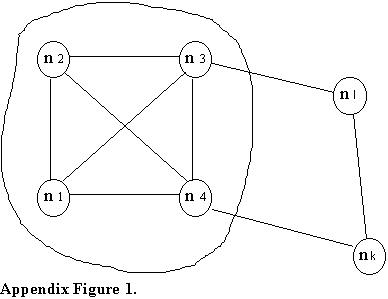
The distances from nodes 1, 2, 3, and 4 (all members of the clique) to node nl are {2, 2, 1, 1} respectively. The minimum of all these distances is 1, therefore the distance from the clique as a whole to the node is defined to be 1.
1. This research was supported in part by a grant from the Dirección General de Asuntos del Personal Académico, UNAM, through Project IN310296. This article was first presented at the Sunbelt 17. San Diego, CA. February 1997
2. Instituto de Investigaciones en Matemáticas Aplicadas y en Sistemas; Universidad Nacional Autónoma de México, (IIMAS-UNAM); Ap. Postal 20-763; Mexico, D.F. CP 01000. México; fax (525) 5502189. Internet: jgil@servidor.unam.mx and jcastro@servidor.unam.mx
3. Department of Political Science; University of Texas at El Paso; El Paso, TX 79968; fax (915) 747 5400 . E-mail: sschmidt@mail.utep.edu
4. School of Sciences; Universidad Nacional Autónoma de México, (UNAM); fax (525) 5502189. E-mail: rarnulfo@servidor.unam.mx
5. Some actors from the third generation (e.g., Salinas) have family connections to the first generation, but this is the exception and not the rule.
6. See Appendix A for an explanation of the In and Ic indexes.
7. The numbers assigned to each actor are arbitrary.
8. This was defined by Schmidt (1991) as the deterioration of the Mexican presidency.